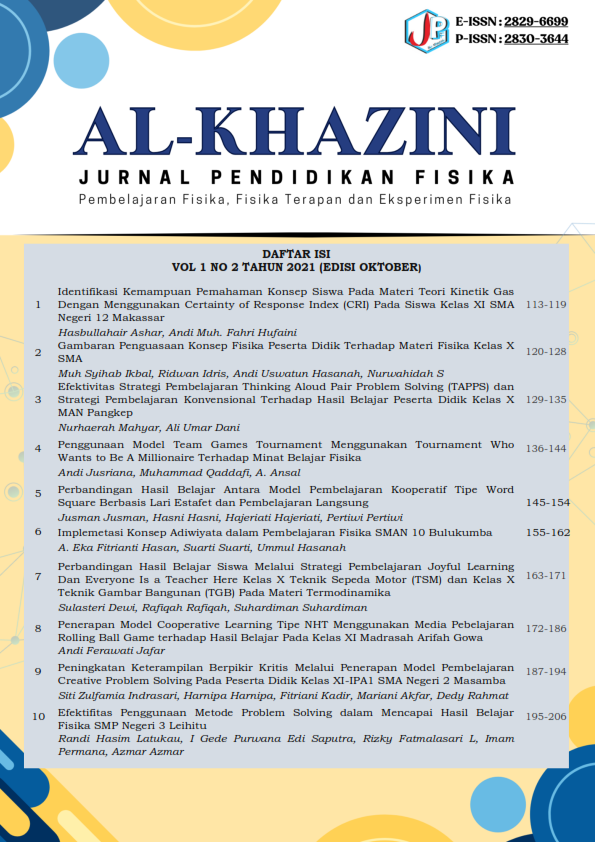Peningkatan Keterampilan Berpikir Kritis Melalui Penerapan Model Pembelajaran Creative Problem Solving Pada Peserta Didik Kelas XI-IPA1 SMA Negeri 2 Masamba
Abstrak
Penelitian ini bertujuan untuk meningkatkan keterampilan berpikir kritis peserta didik kelas XI-IPA1 di SMA Negeri 2 Masamba melalui Model Pembelajaran Creative Problem Solving. Jenis penelitian adalah penelitian tindakan kelas. Subyek dalam penelitian ini adalah peserta didik kelas XI-IPA1 di SMA Negeri 2 Masamba tahun ajaran 2015/2016 yang terdiri dari 36 orang peserta didik. Hasil penelitian menunjukkan bahwa (1) aktivitas pembelajaran peserta didik dengan model pembelajaran creative problem solving mengalami peningkatan dari siklus I ke siklus II, (2) hasil observasi pengelolaan pembelajaran oleh guru pada siklus I dan II berada di atas 80%, sehingga dikategorikan sangat baik, (3) nilai rata-rata hasil tes keterampilan berpikir kritis peserta didik mengalami peningkatan dari siklus I sebesar 72 menjadi 81 pada siklus II, (4) ketuntasan individu dan klasikal keterampilan berpikir kritis peserta didik mengalami peningkatan dari 62.86% pada siklus I menjadi 88.57% pada siklus II.
##plugins.generic.usageStats.downloads##
Referensi
Agung, Tri. 2014. Model Pembelajaran Creative Problem Solving (CPS) untuk Meningkatkan Penguasaan Konsep Fluida Statis dan Kemampuan Pemecahan Masalah Siswa. Tesis. Bandung: Universitas Pendidikan Indonesia.
Depdiknas. 2013. Kurikulum 2013: Implementasi Kurikulum 2013 Sekolah Menengah Atas dan Madrasah Aliyah. Jakarta: Depdiknas.
Dwijananti. 2010. Pengembangan Kemampuan Berpikir Kritis Mahasiswa melalui Pembelajaran Problem Based Instruction pada Mata Kuliah Fisika Lingkungan. Jurnal Pendidikan Fisika Indonesia
Elaine B Johnson. 2007. Contextual Teaching and Learning. Bandung: MLC
Indrayani, Putri. 2012. Model Pembelajaran Creative Problem Solving (CPS) dengan pendekatan open ended untuk meningkatkan kemampuan berfikir kritis peserta didik kelas VIII E SMP Negeri 13 Malang. Tesis. Malang: Universitas Negeri Malang.
Maraviglia, F., and Kvashny, A. 2006. Managing Virtual Change: A Guide to Creative ProblemSolving in Design Professions (Published in 2006 by Author House Publishing).
Gains in Physics. American Journal of Physics, 70 (7). Merrill/Prentice Hall.
Mulyasa. 2011. Metode Penelitian Tindakan Kelas. Bandung: Pustaka Setia.
Muslich, M. 2007. Pembelajaran Berbasis Kompotensi dan Kontekstual. Jakarta: Bumi Aksara.
Myrmel, M. K. 2003. Effek of Using Creative Problem Solving in Eight Grade Tegnology Education Class At Hopkins North Junior High School. Research Paper to Submittedin Partial Fulfillment of The Requirenment for Master of Science Degree. The Graduate Scholl University of Wincinsin: Stout [Online]. Tersedia: http://www.scirus.com
OECD. 2012. PISA 2012 Results in Focus. https://www.oecd.org/pisa/keyfindings/pisa-2012-results-overview.pdf
Pepkin, K. L. 2004. Creative Problem Solving in Math. Tersedia di: http://www.uh.edu/hti/cu/2004/v02/04.htm
Peraturan Menteri Pendidikan Nasional Republik Indonesia Nomor 22 Tahun 2006 Tentang Standar Isi Untuk Satuan Pendidikan Dasar dan Menengah.
Peraturan Menteri Pendidikan Nasional Republik Indonesia Nomor 41 Tahun 2007
Tentang Standar Proses untuk Satuan Pendidikan Dasar dan Menengah.
Sakka, Jamaluddin. 2011. Efektivitas Pembelajaran Kontekstual terhadap Peningkatan Kemampuan Berpikir Kritis dan Berpikir Kreatif pada Pembelajaran Fisika Peserta Didik Kelas X SMA Negeri 8 Makassar. Skripsi. Karya Tidak Diterbitkan. Makassar: Universitas Negeri Makassar.
Sanjaya, Wina. 2011. Strategi Pembelajaran Berorientasi Standar Proses Pendidikan. Jakarta: Kencana.
Suryosubroto. 2009. Proses Belajar Mengajar di Sekolah. Jakarta: PT. Rineke Cipta.
Sujarwo. 2006. Strategi Creative Problem Solving dalam Pemecahan Masalah. Majalah Ilmiah Pembelajaran. No.1.Vol 2.Mei2006. http://jurnal.pdii.lipi.go.id/admin/jurnal/21061327.pdf.
Tawil, Muhammad. 2011. Keterampilan Berpikir Kritis dan Kreatif. Karya tidak diterbitkan.
Treffinger & Isaksen . 2008. Understanding Individual Problem-Solving Style: A key to Learning and Applying Creative Problem Solving. Learning and Individual Differences, 18,390-401
Wiriaatmadja, R. 2006. Metode penelitian Tindakan Kelas. Bandung: Remaja Rosdakarya.
The Authors submitting a manuscript do so on the understanding that if accepted Al-Khazini:Jurnal Pendidikan Fisika for publication, copyright publishing of the article shall be assigned/transferred to Physics Education Department, UIN Alauddin Makassar as Publisher of the journal. Upon acceptance of an article, authors will be asked to complete a 'Copyright Transfer Agreement'. An e-mail will be sent to the corresponding author confirming receipt of the manuscript together with a 'Copyright Transfer Agreement' form by the online version of this agreement.
Al-Khazini:Jurnal Pendidikan Fisika and Physics Education Department, UIN Alauddin Makassar, , and Physics Society of Indonesia as the Editors and the Advisory International Editorial Board make every effort to ensure that no wrong or misleading data, opinions or statements be published in the journal. In any way, the contents of the articles and advertisements published in the Al-Khazini:Jurnal Pendidikan Fisika are the sole and exclusive responsibility of their respective authors and advertisers.
The copyright form should be signed electronically and send to the Editorial Office in the form of the original e-mail: [email protected]

